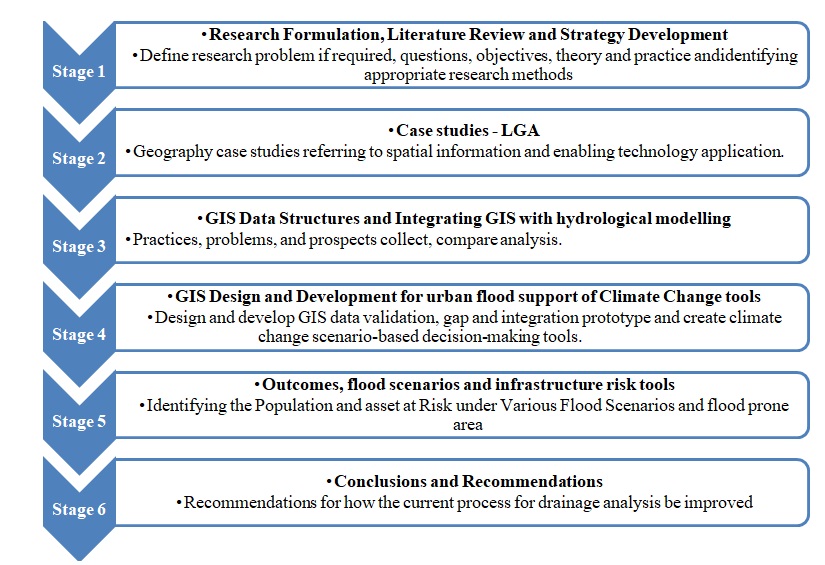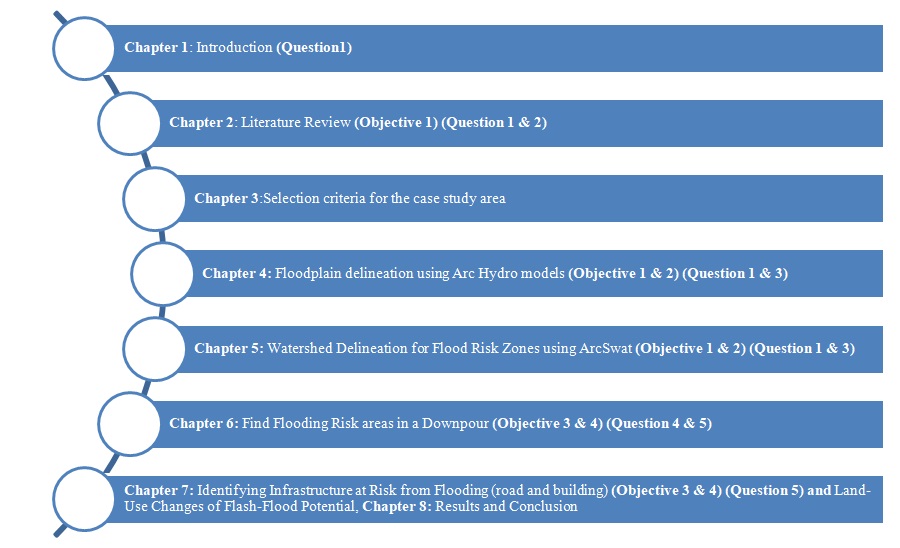Methods
The adoption and diffusion of decision support technology, with application to flood risk management in Victoria, signify the conceptual basis for this thesis. Digital spatial information modelling and the integration of the data and information used in the decision-support system illustrate the technical basis of the paper.
In this research, the relevant data and information were gathered and analysed by the application of a case study approach. As it was noticed by Serrao-Neumann et al. (2013), the contextual analyses allow the researcher to look at natural phenomena in their typical setting and use the information acquired by various methods and sources. Multiple disciplines, from research on information systems operation, apply learning based on cases (Rajabifard et al. 2002, Mohammadi 2008, McDougall 2006). According to the previously mentioned scholars, a case study approach is immensely suitable for investigation of the information systems field because this filed continually innovates and undergoes changes (Rajabifard et al. 2002, Mohammadi 2008, McDougall 2006).
Yin (2003) believes that when the phenomenon under study is identical to its context, the case study research method also could be used. For instance, the complex interactions between advanced technologies and organisations illustrate these circumstances. Hence, case study research methods signify that the researcher asks “how and why” questions, focuses on the contemporary phenomenon within a real-life context, and has the little opportunity to control the events. Therefore, the application of contextual analyses is the most appropriate when the investigator broadly defines research topics and covers not simply disengaged factors but contextual or complex multivariate conditions (Yin 2003). Furthermore, according to Yin (2003), it is essential to use opinions of the technology to understand the actual uses of the technology and potential difficulties being faced by adopters if a case study refers to such innovation as digital spatial information and enabling knowledge. The author of the current research was an employee in the City of Whittlesea (CoW), and this experience allowed him to make observations at the augmented level and investigate the dynamics of surrounding organisational behaviour of the stakeholders towards enabling technology and geospatial data (Yin 2003).
Figure 1.1 reflects the research design of the project that unites a framework for information systems case study research approaches as it was described by Kaplan and Duchon (1988), Lee and Heaney (2003), Onsrud et al. (1992) and Yin (2003). The first stage of the research design is comprised of the detailed project formulation, including reviewing of the relevant theory and practice that provides the foundation for the further improvement of an appropriate theoretical framework for data collection and evaluation. This is possible due to the utilisation of data and information collected through mixed research methods used at the second stage. The third stage uses data and information gathered at the preceding step of the research. These materials were obtained in the result of the development of a suite of flood management (FM) stakeholder needs-focussed geospatial tools for the implementation within the Victorian FM program. FM program created for Victoria is universal and, therefore, could be adapted to other national and world-wide FM programs.
The data and information that were obtained during the first two stages are used for further investigation at the third stage of the research. The outputs of the first three steps form the fourth stage that includes the conclusions and recommendations of this thesis.

The final conclusions and recommendations of the present research paper will be based on the synthesis and analysis of the first, second, and thirds stages. The first two stages present information on the of a GIS-embedded hydrological model with machine learning techniques, to improve administrative practices informed by flood hazard modelling. This information includes a review of literature dedicated to the floodplain management in the Victoria setting. Apart from that, it also consists of the user needs of spatial analysis and the concept of hydrological modelling using Light Detection and Ranging (LiDAR).
The discussion presented in the third and fourth stages highlights the following topics:
- GIS functionalities in hydrological modelling and LiDAR data implementation for the Victorian Council’s flood model;
- The importance of the spatial database for “on-request” hydrological modelling;
- Flood modelling through an examination of GIS datasets to detect the gaps in spatial information and the essential characteristics;
- GIS in Water Resources with machine learning and Flood Risk Management;
Data used at the first and the second stages of the research focuses on flooding and floodplain management in the Australian settings. The utilisation of LiDAR enables users to perform a spatial investigation and a reasonable hydrological visualisation. The examination of GIS functionalities in hydrological and LiDAR applications conducted at the third and fourth stages shows the effects along the Victorian creek. These stages investigate the importance of GIS database for ‘on-request’ hydrological examination and flood modelling over the use of spatial datasets. This investigation allows to reveal the gaps in GIS information and indicate the required characteristics of hydrology models for flood modelling. As a result, the fourth stage will address the central problem of the present research and its objectives.
The knowledge gained from this project could be used to inform future FM and provide spatial information infrastructure (SII) policy reforms in Victoria. Additionally, the results of the research might close the previously mentioned policy-to-practice gaps related to the integration of spatial decision-support for FM in Victoria.
Structure and Outline of the Thesis
Figure 1.2, presented below, reflect the structure of the thesis that is comprised of eight chapters.

As it has already been stated, the first stage of the research is comprised of research formulation, literature review and development of the strategy. Chapter 1 includes the introduction and the theoretical framework of the thesis. It also described the problem, aim, and questions of the research. The literature review on flooding, flood management, GIS and Hydrological modelling could be found in Chapter 2 that answers the first and the second research questions.
The second stage includes the case studies and the pilot study area that are described in chapter 3 “Pilot study area: City of Whittlesea (CoW)”. This section explains the standards for choosing the pilot study area (the CoW) and hydrological and associated qualities of this area.
The focus of the third step of the thesis is directed at GIS data structures and processes for integrating GIS with hydrological modelling. Therefore, chapter 4 discusses a case study aimed at floodplain delineation using ArcHydro models, the choice of methods and user data information needs in the context of local flood-risk analysis. It depicts the strategies and result of spatial information linking for extricating overland flow through the property and reduces the risk of flash flooding area utilizing GIS-embedded hydrological model with machine learning techniques. In this chapter, the author also discusses the limitations in existing local flood relevant spatial databases and answers the first and the third research questions.
Chapter 5 includes a case study on the watershed delineation of flood risk zones through ArcSwat. The numerical models, introduced in this chapter, can simulate hydrological processes by ArcSWAT. This chapter answers the research questions one and three.
Stage four involves GIS design and development for flood support of climate change tools. Chapter 6 that is a case study on finding areas at risk of flooding in a downpour, presents the results of the fourth step. This chapter applies the DEM dataset in GIS-embedded hydrological model with machine learning techniques and answers the fourth and the fifth research questions.
The penultimate stage of the thesis paper reveals the outcomes, flood scenarios and infrastructure risk tools. Chapter 6 is comprised of a case study which develops an approach for identifying infrastructure at risk from flooding, LiDAR modelling of flood inundation under future and describes the current and future threats to infrastructure. Since chapter 7 is dedicated to the discussion of GIS, remote sensing, and machine learning, it highlights the correlation between the land-use changes and flash-flood potential. Chapter 7 answers the sixth research questions.
The objective of the final stage of the research is to present conclusions and recommendations. Chapter 8 that is the synthesis of findings, contains the results of this stage, conclusions and recommendations for future research for improving Victoria’s flood management. In addition, the last chapter provides suggestions for future research. Chapter 8 addresses the problem and primary research objectives as well as the ways for future research.
Scope and the Key Assumptions of the Research
Undoubtedly, “spatial industry” faces certain limitations in term of the implementation of policies directed at the mitigation of climate change (Douglas et al. 2008). This is illustrated by the consequences of flood management practices used in Victoria in 2016. Thus, the critical assumption of the research is that the modern models of floods have the capability to make predictions only about urban areas. Furthermore, DEM datasets regard urban landscapes as a stable during the whole time of the disaster. The conclusions that were reached in the fourth, fifth, sixth and seventh chapters of the paper depict that it would be more beneficial to use different tools to estimate the impact that floods would cause for infrastructural objects. The sections from fourth to seventh bring novelty to the scientific community since the bridge the gap of the limited research on simulation of floods impact on infrastructure.
Most importantly, there is no other research that would build an investigation of interdependencies between flash-flood potential and land-use changes upon the combination of GIS and hydrology model with machine learning. At the same time, it must be admitted that the area that was used for the analysis in the paper was not affected by a flood. Nevertheless, despite this fact, the presented procedure is universal and, consequently, could be applied in any other area without exceptions.
Summary
The first chapter formulates the scientific and practical values of the research, its aims, objectives, structure and could be viewed as the framework and the foundation for the subsequent chapters. The second chapter reviews the literature on such topics as GIS, hydrology, and information models that are applied for the analysis. The following four sections describe the case study and by formulating the results not only answer the research question but also bring novelty to the issued field of research.